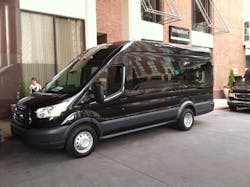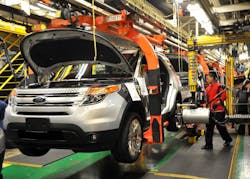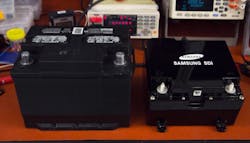KANSAS CITY. Ford Motor Co. announced this week that the two gasoline engine equipped versions of its new 2015 Transit full-size van will deliver in some cases nearly 50% better fuel economy versus comparable Econoline E-Series van models the Transit line is replacing, according to official Environmental Protection Agency (EPA) test data.
When equipped with the optional 3.5-liter EcoBoost engine, the 2015 Transit low- and medium-roof regular wheelbase wagons achieve a 14 mpg city/19 mpg highway EPA-estimated rating – an improvement of as much as 46% over the 10 mpg city/13 mpg highway EPA-estimated rating for the Ford E-Series 6.8-liter V10 premium gas engine.
Those improved gas mileage figures translate into fuel savings as high as $1,700 annually, Ford pointed out, based on the EPA’s data.
Low- and medium-roof regular wheelbase wagon Transit models equipped with the standard 3.7-liter V6 get a 14 mpg city/19 mpg highway EPA-estimated rating – up to 19% better than the 13 mpg city/16 mpg EPA-estimated rating for the E-Series 4.6-liter V8 standard gas engine. That differential translates into fuel savings of as much as $650 a year, the OEM noted, according to EPA estimates.
The 3.2-liter Power Stroke diesel engine option for the Transit, however, isn’t EPA-rated so no “official” fuel economy stats are available for it at this time, Ford said.
“Fuel economy is where it’s at right now,” Derek Bier, Ford’s vehicle engineering supervisor, told Fleet Owner at a ride and drive event being held here for journalists. “Then you add to that the high-roof option, which allows you to stand up and work inside the vehicle. Those are critical improvements.”
[Ford is also introducing a new vehicle paint process with the Transit rollout as well.]
Ford added that compressed natural gas (CNG) and liquefied petroleum gas (LPG) prep packages are available for Transit van, when models are spec’d with the standard 3.7-liter V6 gasoline engine.
Obtaining official EPA fuel economy ratings for the Transit comes on the heels of one Ford’s best sales months in recent years.
The OEM said its U.S. sales totaled 254,084 vehicles in May, up 3% from a year ago, with retail sales for several models setting records with 174,889 vehicles sold – an increase of 6% versus the same month in 2013.“The Fusion [sedan] and Escape [compact sport utility vehicle] had their best months ever, which helped us to our strongest May result since May 2004,” noted John Felice, Ford’s VP-U.S. marketing, sales and service, in a statement. “The Explorer {SUV] continued to gain ground in the midsize utility segment with its best monthly sales performance in nearly 10 years, while Lincoln MKZ saw its best May ever.”
For example, with 31,896 vehicle sales, Ford’s Escape posted an all-time record, topping the 30,000-vehicle mark for the first time ever. Ford’s Explorer sales in May topped the 20,000-vehicle mark for the first time since July 2005 with sales of 20,346 vehicles – a 21% increase over the same month in 2013.
Combined Escape and Explorer sales of 52,242 vehicles helped increase total SUV sales by 9% – the best monthly sales performance for Ford’s SUVs since July 2005, Felice said.
Ford also cinched a deal with Samsung SDI this week – an affiliate of the Samsung Group – to pursue research on different levels of hybrid technology that could one day be produced in high volume on non-hybrid vehicles for greater fuel savings.
The result of a 10-year research effort, Ford said a new dual-battery system combines a lithium-ion battery with a 12-volt lead-acid battery that could enable regenerative braking technology in non-hybrid vehicles for greater fuel savings.“We are currently expanding our auto start-stop technology across 70% of our lineup, and this dual-battery system has the potential to bring even more levels of hybridization to our vehicles for greater energy savings across the board,” noted Ted Miller, Ford’s senior manager for energy storage strategy and research, in a statement. “Although still in research, this type of battery could provide a near-term solution for greater reduction of carbon dioxide [CO2].”
Currently available on Ford’s hybrid vehicles, regenerative braking enables the battery to capture up to 95% of the electrical energy normally lost during the braking process for reuse. The system works in conjunction with the OEM’s auto start-stop system, which turns off the engine when a vehicle stops to save fuel. The battery system then takes over to power the vehicle in place of the engine until the driver begins to release the brake pedal, which restarts the engine.
Ford said it is also working with Samsung SDI also on a longer-term ultra-lightweight lithium-ion battery that could one day render traditional lead-acid batteries obsolete.
“Lithium-ion batteries are typically used in consumer electronics because they are lighter and more energy-dense than other types of batteries, which also make them ideal for the vehicle,” said Mike O’Sullivan, VP-automotive battery systems for Samsung SDI North America, in a statement. “Battery technology is advancing rapidly and lithium-ion could one day completely replace traditional 12-volt lead-acid batteries, providing better fuel efficiency for drivers.”
Lithium-ion batteries currently used in Ford’s electrified vehicles are 25% to 30% smaller than previous hybrid batteries made of nickel-metal-hydride, and offer approximately three times the power per cell, the OEM noted.
The ultra-lightweight battery concept offers a weight reduction of up to 40%, or 12 pounds. Combining the battery with other weight reduction solutions could lead to additional savings in size and weight of the overall vehicle, as well as increased efficiencies and performance, Ford said.
About the Author
Sean Kilcarr
Editor in Chief
Sean Kilcarr is a former longtime FleetOwner senior editor who wrote for the publication from 2000 to 2018. He served as editor-in-chief from 2017 to 2018.


